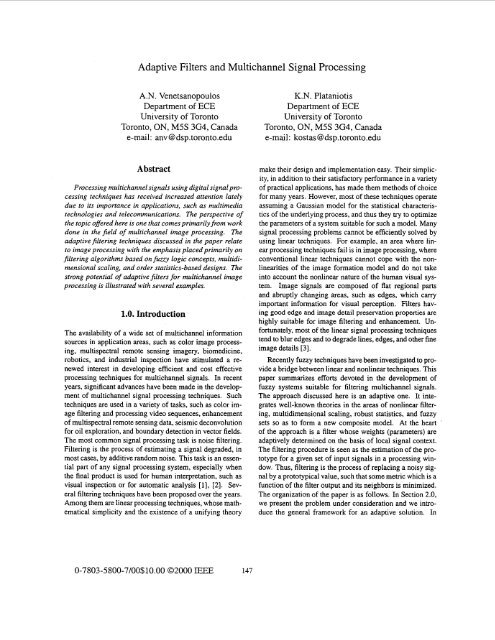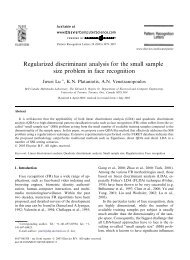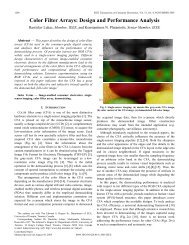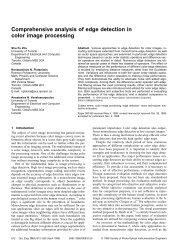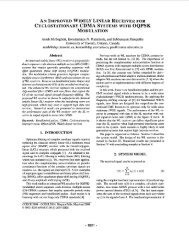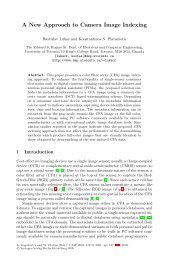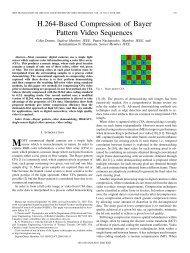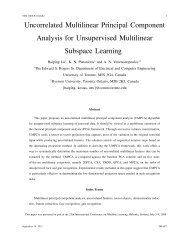Adaptive filters and multichannel signal processing ... - IEEE Xplore
Adaptive filters and multichannel signal processing ... - IEEE Xplore
Adaptive filters and multichannel signal processing ... - IEEE Xplore
You also want an ePaper? Increase the reach of your titles
YUMPU automatically turns print PDFs into web optimized ePapers that Google loves.
Biennial Report2012–2013MOVING
Section 3.0 we review membership functions based on thedistance <strong>and</strong> similarity measures used in <strong>multichannel</strong> <strong>signal</strong><strong>processing</strong> applications [4]. Properties, characteristics,<strong>and</strong> implementation issues are also discussed in detail. Section4.0 deals with the problem of color image <strong>processing</strong>,an important area of <strong>multichannel</strong> <strong>signal</strong> <strong>processing</strong>, wherewe present experimental results <strong>and</strong> comparisons with otherst<strong>and</strong>ard methods. Finally, Section 5.0 summarizes the conclusions<strong>and</strong> describes future research.2.0. The General FrameworkConsider the following commonly used model for a <strong>multichannel</strong><strong>signal</strong> corrupted by additive noise: x = y + no,where y denotes the m-channel uncorrupted <strong>signal</strong> vector,x is the corresponding noisy vector to be filtered <strong>and</strong>no an additive noise vector. The <strong>signal</strong> <strong>processing</strong> literaturehas been dominated by the assumption of the Gaussianmodel for the statistical characteristics of the noise.Optimal filtering solutions for the problem at h<strong>and</strong> can bedevised based on this assumption. Although the Gaussianmodel is often justified in practice by the central limittheorem, we often encounter noise processes that exhibitimpulsive behavior <strong>and</strong> are more accurately modeled byheavy-tailed, non-Gaussian distributions [5], 161. Impulsivebehavior can be characterized in terms of short duration,high-energy spikes attaining large amplitudes withprobability higher than that predicted by a Gaussian densitymodel. Even if the level of non-Gaussian noise contaminationis small, the performance of a filtering systemoptimized under the Gaussian assumption can suffer fromdrastic degradation. In such a case, the performance ofclassical adaptive filtering schemes, such as recursive leastsquares (RLS)[7] or simple weighted average <strong>filters</strong>, is seriouslydegraded. Thus, there is a need for a flexible <strong>and</strong>efficient filter class for non-Gaussian environments that canappear in practice. Let us define x(Z) as the <strong>multichannel</strong>sample to be processed at time index 2 <strong>and</strong> let W be a setof (n = 2N + 1) neighboring samples which belong tothe window W centered on XI: W = [x~,xz, ..., xn] =[XI-N, ..., XI-1 , XI, x1+1, ..., XI+N]. Since the most commonlyused method to decrease the level of r<strong>and</strong>om noisepresent in the <strong>signal</strong> is smoothing, an averaging operationis required in order to replace the noisy vector at the windowcenter with a suitable representative vector (prototypicalvalue). The general form of the system presented here isgiven as a weighted average of the input vectors inside thewindow W. Thus, the uncorrupted <strong>multichannel</strong> <strong>signal</strong> is estimatedby determining the centroid as follows [4], [8]-[9]:nwhere f(pj) = p; is a function adaptively determined onnthe basis of local context with pj the membership functionof input xj <strong>and</strong> X a parameter such that X E [0, cm) . Inthis adaptive design the weights provide the degree to whichan input vector contributes to the output of the filter. Therelationship between the <strong>signal</strong> at the window center (vectorunder consideration) <strong>and</strong> each <strong>signal</strong> within the windowshould be reflected in the decision for the weights of the filter.Through the normalization procedure, two constraintsnecessary to ensure that the output is an unbiased estimatorare satisfied. Namely, (i) each weight is a positive number,wj 2 0, <strong>and</strong> (ii) the summation of all the weights is equal tounity: E:=,wj = 1. The weights can be considered to bea membership function with respect to the specific windowcomponent. The adaptive algorithm evaluates a membershipfunction based on a given vector <strong>signal</strong> <strong>and</strong> then usesthe membership values to calculate the final filtered output.To explain the concepts behind the filter only the definitionof the fuzzy set is required. Other definitions, such asfuzzy rule bases <strong>and</strong> fuzzy control are not essential to thiswork <strong>and</strong> thus are omitted. Assume that X is a universeof discourse with elements x. Then, a fuzzy set A in x isa set of ordered pairs A = [ eIxEX], where p~(x) isthe membership function or grade of membership of x inA which maps X into a membership space M. The rangeof the membership function is a subset of the non-negativereal numbers whose supremum is finite. In practical applicationsM is normalized to the interval [0,1]. The designsummarized here qualifies as an adaptive fuzzy systemsince it utilizes sample input data <strong>and</strong> inference procedures(here in the form of transformed distance metrics), to definea fuzzy system at each time instant. Through the adaptationmechanism utilized, the system structure changes overtime resulting in a time-varying mapping between input values<strong>and</strong> filtered output. This temporal mapping defines anadaptive fuzzy system. As was argued in [IO], adaptation,or learning, is essentially parameter changing. Thus, bychanging the weights in (I), we have developed an adaptivefuzzy system capable of learning new associations betweeninput patterns <strong>and</strong> new functional dependencies. The noisesmoothing problem is seen as a problem of prototype estimationgiven a set of <strong>signal</strong> inputs. In this sense, filteringis the process of replacing the noise-corrupted <strong>multichannel</strong><strong>signal</strong> at the window center by a prototype <strong>signal</strong>, suchthat the differences between this prototype <strong>and</strong> all its neighborsinside the window are minimized in some sense. Thisoperation is, essentially, a defuzzification procedure. It determinesthe most appropriate <strong>signal</strong> value (a vector <strong>signal</strong>in the case of <strong>multichannel</strong> inputs), to represent a collectionof elements whose membership functions have beenconstructed over a universe of discourse. Although a numberof different defuzzification strategies exist, the centroiddefuzzification approach, known as the Center of Gruvify(COG), is often utilized in practice. The COG method148
generates a defuzzified value which is at the center of thevalues of a fuzzy set. Its defuzzified output actually correspondsto the membership-graded weighted mean of thesquare (Euclidean) distance. To clarify this, let us considera fuzzy set A that is defuzzified as: A = (fi, E, ..., 5)where ,U, is the membership function associated with theinput value x, . If a quadratic cost function is considered:K(%) = cy=, Ixi - %lTpilxi - 21 the COG defuzzifiedvalue is obtained when K(%) is minimized by differenti-ation:= -e.Simple inspection of the COG de-fuzzified value obtained reveals the similarity with the adaptivefiltered output of (1). We can therefore claim that theoutput of our adaptive filter can be considered as the outputof the COG defuzzification strategy with the noisy <strong>multichannel</strong><strong>signal</strong>s as members of a fuzzy set <strong>and</strong> the membershipfunctions pi , i - 1,2, ..., n defined over them. In sucha design, the overall performance of the <strong>processing</strong> systemis determined by the defuzzification procedure selected.The quadratic cost function discussed above can be generalizedto include any arbitrary function of ,U. Under such ascenario, we assume that the cost function associated withthe selection of the defuzzified value to represent the fuzzyTset A is: K(%) = Cy', !xi - 21 f(pi)lxi - 31 wheref(pi) is a function of the associated membership func-tion. By minimizing the above quadratic form, a defuzzi-fied (crisp) value can be obtained as: 7 =which is identical to the form used to generate the filteredoutput in the adaptive design of (1). If the power functionf(pi) = ,U; with XE[O,co) is used, the defuzzifiedvalue can be obtained through the following equation:xir:Y = .-. It can easily be seen that, in the gener-alized defuzzification rule, if X = 1 the widely used COGstrategy can be obtained. The defuzzified vector-valued <strong>signal</strong>obtained through the COG strategy is a vector-valued<strong>signal</strong>, which was not part of the original set of input vectors.However, there are <strong>signal</strong> <strong>processing</strong> applications,such as image filtering, where it is desirable for the filteroutput to be one of the samples in the input window. As anexample, the vector median filter (Vh4F) [ 111 is always constrained,by definition, to be one of the input samples. Thus,if the output of the adaptive fuzzy system is required to bea member of the original input set, a different defuzzificatioristrategy should be used. By defining p(maz) to be thelargest membership value, the adaptive weights in (1) canbe rewritten as follows: w. -Given that pj < p(maz) , as X+cox.'E?= xif(Mi)A I 'j )Athen:Eq. (2) represents the maximum defuuijier strategy. If themaximum value occurs at a single point only, the maximumdefuzzifier strategy coincides with the mean of m-ima (MOM) defuzzification process. Through the mimumdefuuifier, the output of an adaptive fuzzy system is definedas: y = xj ,U' - /qmaz). In this case, the fuzzy adaptivefilter behaves as a mode-like selection filter since by constructionits output is always one of the samples inside the<strong>processing</strong> window. This selection property is shared bywell-known nonlinear <strong>filters</strong>, such as the VMF <strong>and</strong> the myriadfilter [6]. However, unlike these <strong>filters</strong>, which are optimizedfor specific noise models (the Laplacian <strong>and</strong> Cauchymodel respectively), the fuzzy filter can be optimized forany noise model by tuning its membership function. Thusexisting selection <strong>filters</strong> can be generalized.3.0. Determining the ParametersThe most crucial step in the design of the adaptive fuzzysystem lies in determining the membership function to beused in the construction of its weights. The difficulties associatedwith the meaning <strong>and</strong> measurement of the membershipfunction hinder the applicability of fuzzy techniquesto many practical applications. Our analysis considers themembership function as a function of similarity. Viewingmembership values as similarity indicators is often used inprototype theory where membership is a notion of beingsimilar to a representative of a category [12]. Thus a membershipfunction value can be used to quantify the degreeof similarity of an element to the set in question. The assumptionbehind this approach is that there exists a perfect(ideal) example of the set which belongs to the set to thefull degree. The valuation of membership for the rest of theelements in the set can be regarded as the comparison of agiven input xi with the ideal input xr , which results in adistance d(xi, xr). The generic form of our function wasgiven in [13] as: pa = &, where f(-) is a function ofthe distance between the vector <strong>signal</strong> xi <strong>and</strong> the ideal prototypexr . Membership functions are either monotonicallyincreasing functions from 0 to 1, monotonically decreasingfrom 1 to 0, or can be divided into monotonically increasingor decreasing parts. Each increasing or decreasing partis specified by a cross-over or dispersion point. The particularfunction f(di) used in the equation will determine theactual shape of the membership function. The approach of[ 131 suggests that since the relationship between distancesmeasured in physical units <strong>and</strong> perception is generally exponential,an exponential type of function should be usedin the generic membership function. The resulting type ofa sigmoidal function deduced from this proposition can bedefined as:Pi(xi) = + ,,.(-c(s(xi,x~)-a~)011)'(3)149
with lims,m pi = 1 <strong>and</strong> lims,o pi = 0 for a monotonicallyincreasing function, where s(xi, x,) is any similarityfunction between two vectors <strong>and</strong>Pi (xi) =1+ e.p( -c(dp(xi,xT)-az) '02 1with limd,, pi = 0 <strong>and</strong> limd,o pi = 1 for a monotonicallydecreasing function, where dp(xi, x,) is any memberof the generalized Minkowski family of metrics. In caseswhere a distance measure is used to quantify dissimilaritybetween the vector under consideration <strong>and</strong> the ideal prototype,the decreasing form of the function is utilized. If asimilarity measure is used instead, we consider the monotonicallyincreasing version of the membership function.The model of (3)-(4) satisfies the requirement imposed bythe adaptive fuzzy framework. However, the membershipfunction in its present form is computationally expensivesince it involves the evaluation of the exponential function,<strong>and</strong> more importantly its parameters cannot be evaluatedeasily in practical applications. Therefore, other functionswhich can retain the same characteristics <strong>and</strong> are easier toimplement are needed. Such a membership form was proposedin [ 121. This function is continuously increasing (decreasing),satisfies the same boundaries conditions, complieswith the generic membership function, <strong>and</strong> retains theproperties of the S-shaped membership function. However,unlike the function in (3)-(4) it can be written as a rationalfunction of two polynomials. In the new formulation, forany input value z, the membership function, by construction,can be completely characterized by only four parameters:(i-ii) the interval [a, b] of the input parameter z, (iii)the sharpness X of the membership function, <strong>and</strong>, (iv) theinflection point v of the S-shaped function. Based on theseparameters a membership function can be defined as:PL(Z) =x(1- V y ( z -a)(1 - v)x-l(z - ay + /2-'(b - z)x 'for a monotonically increasing function, <strong>and</strong>P(Z) =(4)(5)(1 - v)x-l(b - z px1 (6)(1 - v y ( b- z y + pX-'(z - a)for a monotonically decreasing function, with the inflectionpoint v defined via ~ (z,) = v <strong>and</strong> z, = (b- a). + a orz, = (a - b)v + b for the case of monotonically increasingor decreasing functions respectively. The sharpness ofthe function (an indicator of increasing/decreasing membership)can be defined respectively as:X = f'(z - v)(b - a).This membership function, which is universally applicable,can be utilized by considering the distance or similar-ity value as the input to the membership function. Assumethat di = dp(xil x,) <strong>and</strong> si = &(xi - x,) are appropriatedistance or similarity measures between the vector underconsideration <strong>and</strong> the ideal prototype, similar to those discussedin the previous section, we may rewrite the membershipfunction needed in the fuzzy system of (1) as follows:(1- v)x-l(dmaz -dipPi =(1- v)x-l(dmaz - day + /!L+'(di - d,Z*y(7)with di E [dmaz,&in].Alternatively a monotonically increasingfunction can be defined based on a similarity measuresi = si(xi - x,) as follows:with siE[smaz,smin]. For the case of X = 1 the linearform of the membership function is obtained: pi =s;--Sminfor a monotonically increasing function, <strong>and</strong>Smaz -Smind -d.Pi = for a monotonically decreasing function,c-d.,,inwhich corresponds to the nearest-neighbor rule used in [3],[4] to define membership functions. The membership functionis critically dependent on the similarity measure <strong>and</strong>the reference point selected. The ideal reference <strong>signal</strong> isthe actual value of the multidimensional <strong>signal</strong> in the specificlocation under consideration. This <strong>signal</strong>, however, isnot available. In addition, the noisy vector at the same locationis not the appropriate choice since any input vectorinside the window can be an outlier. Therefore, to makethe procedure more robust <strong>and</strong> to ensure that the fuzzy systemwill provide accurate results, we eliminate the need fora reference point by evaluating the membership functionused to weight each input vector xi in (1) on the aggregatedistance between the vector xi under consideration <strong>and</strong> allthe other vectors inside the <strong>processing</strong> window. Thus, thevector with the smallest overall distance (or maximum similarity)is now assigned the maximum membership value.Needless to say the membership function selected is nowevaluated on the aggregated distances <strong>and</strong> not on the distancebetween the vector <strong>and</strong> the ideal prototype. It is obviousthat such a design does not depend on a reference point<strong>and</strong> thus is more robust to occasional outliers. However, thecomputational complexity of the algorithm increases as aresult of the need to evaluate a number of distances (similarities)in the <strong>processing</strong> window. Many distance metricor similarity functions [ 141, [3] can be used in the formulationof the aggregate distance. For example, assumethat the noisy vector xi inside the <strong>processing</strong> window Wis considered. Its aggregated distance from all other vecd2(xi1xj)tors inside the window is given as: di = cy=,(zf - z:)~)~ iftheEuclideanmetrichas been selected to measure dissimilarity between twovector <strong>signal</strong>s. This aggregate distance value is used as aninput to the membership functions of (4) or (7) that willwith d2(i,j) = (Er='=,150
e used to determine the fuzzy weights in the <strong>multichannel</strong>filter. Similarly, the vector angle criterion defines thescalar measure: d,i = Cy=, A(xi, xj) as the distanceassociated with the noisy vector xi inside the <strong>processing</strong>window of length n, when the angle between two vectorsxixrA(xi, xj) = cos-’ (e,)is used to measure dissimilarity.The approach suggested here eliminates the need for areference point <strong>and</strong> generalizes the concept of membershipfunction as a similarity indicator. In the suggested formulation,the valuation of membership is regarded not as a comparisonwith an ideal point but as a comparison to the rest ofthe elements to be included in the fuzzy set. To summarize,we have outlined a possible interpretation of the membershipfunction <strong>and</strong> discussed how membership functions canbe built based on similarity concepts. A generalized modelfor building membership functions was utilized here. Thedifferent similarity or distance measures discussed here canbe used as input values to this membership function model.The possibility of tuning the design parameters, namely distance(similarity) metrics <strong>and</strong> membership functions providesthe adaptive fuzzy system of (1) with a rich varietyof modes of operation that range from simple selection type<strong>filters</strong>, such as the VMF to hybrid FIR/nonlinear <strong>filters</strong>, suchas the a-trimmed filter.4.0. Color Image ProcessingThe adaptive <strong>filters</strong> discussed here can be used to process<strong>multichannel</strong> <strong>signal</strong>s in a variety of practical applications,such as color image <strong>processing</strong>, medical imaging,remote sensing applications, geophysical <strong>signal</strong> <strong>processing</strong><strong>and</strong> military communications. Due to numerous practicalapplications, color images comprise an important class of<strong>multichannel</strong> <strong>signal</strong>s <strong>and</strong> thus they can serve as an excellentillustrative application. We have conducted a set ofexperiments in order to evaluate the adaptive designs <strong>and</strong>compare their performance against the performance of other<strong>filters</strong>. The noise attenuation properties of the different <strong>filters</strong>are examined by utilizing the widely used 512x480RGB color image ‘Peppers’. The test image has been contaminatedusing various noise source models in order to assessthe performance of the <strong>filters</strong> under different scenarios.The test image is contaminated with: (1) Gaussiannoise (a = 30), (2) impulsive noise (4%), (3) Gaussian(a = 15) impulsive (2%) , <strong>and</strong> (4) Gaussian (CJ = 30) impulsive(4%). The normalized mean square emor (NMSE)has been used as quantitative measure for evaluation purposes.Since it is impossible to discuss all the adaptive<strong>filters</strong> resulting from the theory introduced here, we insteadconstruct five different <strong>filters</strong> based on our designs.These <strong>filters</strong> are compared in terms of performance withother widely used <strong>multichannel</strong> <strong>filters</strong>, such as Basic vectordirectionai filter (BVDF), Generalized vector directionalfilter (GVDF), Arithmetic mean filter (AMF), Directionaldistancefilter (DDF), Vector median filter (VMF) [3] <strong>and</strong>the Hybrid directional filter (HF) <strong>and</strong> <strong>Adaptive</strong> hybrid directionalfilter (AHF) [ 151. In particular, we introduce a simplerank-order filter (hereafter referred to as content-based rankfilter (CBRF)), which can be seen as an adaptive systemutilizing a maximum defuzzifier. We also include the fuzzyvector directional filter (FVDF) which is based on the COGdefuzzification rule, the membership formula of (4), <strong>and</strong> thed,, aggregated distance evaluated over the filtering windowW. Also included in the set, the adaptive nearest-neighborfilter (ANNF) which is based on the maximum defuzzificationstrategy, the linear version of the membership functionformula of (7), <strong>and</strong> the distance measure of di. Further,we utilized the same defuzzification formula <strong>and</strong> the samemembership function, along with the aggregated distance ofd2 to derive the double window nearest neighbor filter AN-NME By using the Canberra distance [3] <strong>and</strong> the distancemeasure of di instead of the angular distance, four new <strong>filters</strong>have been devised, namely the CANNF, CANNMF,CBANNF, <strong>and</strong> the CBANNME From the results listed inthe tables, it can be easily seen that the adaptive designsprovide consistently good results in all types of noise, outperformingthe other <strong>multichannel</strong> <strong>filters</strong> under considerationhere. The versatile design of (1) allows for a numberof different <strong>filters</strong> which can provide solutions to manytypes of different filtering problems. Simple adaptive designs,such as the ANNF or the CANNF can preserve edges<strong>and</strong> smooth noise under different scenarios, outperformingother widely used <strong>multichannel</strong> <strong>filters</strong>. If knowledgeabout the noise characteristics is available, the designer cantune the parameters of the adaptive filter to obtain better results.Finally, considering the number of computations, thecomputationally intensive part of the adaptive fuzzy systemis the required distance calculation. However, this step iscommon in all <strong>multichannel</strong> algorithms considered here. Insummary, the design is simple, does not increase the numericalcomplexity of the <strong>multichannel</strong> algorithm, <strong>and</strong> deliversexcellent results for complicated <strong>multichannel</strong> <strong>signal</strong>s, suchas real color images.5.0. ConclusionsThe paper reviewed a framework for adaptive <strong>multichannel</strong><strong>signal</strong> <strong>processing</strong> based on fuzzy concepts. The frameworkcombines nonlinear <strong>filters</strong>, fuzzy membership functions<strong>and</strong> distance (similarity) criteria. Several <strong>filters</strong> canbe considered special cases of this framework. The behaviorof these adaptive designs was analyzed <strong>and</strong> their performancewas compared with that of the most commonlyused <strong>filters</strong> for a problem of great practical importance,namely color image <strong>processing</strong>. Multichannel <strong>signal</strong> <strong>processing</strong>is a rich <strong>and</strong> exp<strong>and</strong>ing field. Numerous new <strong>and</strong>advanced areas have appeared which have increased the im-151
portance of the tools introduced <strong>and</strong> analyzed here. Multimedia<strong>signal</strong> <strong>processing</strong>, visual data <strong>processing</strong> <strong>and</strong> analysismultimodal <strong>signal</strong> <strong>processing</strong> telecommunications, digitalaudio restoration, satellite imagery, seismic deconvolution,<strong>and</strong> biomedicine are only some of the areas in whichthe methodologies proposed here can be applied. From along-term research perspective, there is a need to establisha coherent theoretical foundation for nonlinear filtering algorithms.New algorithms <strong>and</strong> methodologies which mayresult in even more effective filtering structures suitablefor intelligent <strong>processing</strong> of multimedia <strong>signal</strong> <strong>processing</strong>dem<strong>and</strong> investigation. The framework presented here canserve as an initial point for further research <strong>and</strong> developmentin the area, <strong>and</strong> ultimately help in the development ofnew results <strong>and</strong> products in the near future.Table 1. NMSE(x10-2) for the RGB ’peppers’image, 3x3 windowFilterNoneBVDFCBRFGVDFDDFVMFFVDFANNFA”MFHFAHFCANNFCANNMFCBANNFCBANNMFReferencesNoise Model1 2 3 45.027 6.53 3.29 6.513.93 1.510 0.86 1.491.96 0.47 0.44 0.471.85 0.46 0.36 0.463.51 0.59 0.56 0.591.84 0.37 0.33 0.381.46 0.43 0.34 0.411.110 0,510 0.31 0.520.91 0.36 0.31 0.341-59 0.47 0.36 0.481.43 0.43 0.36 0.471.19 0.47 0.35 0.470.90 0.47 0.43 0.461.23 0.46 0.46 0.440.89 0.45 0.43 0.46I. Pitas, A.N. Venetsanopoulos, Nonlinear Digital Filters:Principles <strong>and</strong> Applications, Kluwer Academic, Norwell Ma.,1990.I. Pitas, A.N. Venetsanopoulos, ‘Order statistics in digital image<strong>processing</strong>’, Proceedings of <strong>IEEE</strong>, vol. 80, no. 12, pp.1893-1923, 1992.K.N. Plataniotis, A.N. Venetsanopoulos, Color Image Processing<strong>and</strong> Applications, Springer Verlag, Berlin, in press.K.N. Plataniotis, D. Androutsos, A.N. Venetsanopoulos,‘<strong>Adaptive</strong> fuzzy systems for <strong>multichannel</strong> <strong>signal</strong> <strong>processing</strong>’,Proceedings of the <strong>IEEE</strong>, vol. 87, no. 9, pp. 1601-1622, 1999.Table 2. NMSE(X~O-~) for the RGB ‘peppers’image, 5x5 windowFilter -1 Noise ModelNoneBVDFCBRFGVDFDDFVMFFVDFANNFANNMFHFAHFCANNFCANNMFCBANNFCBANNMF1 2 3 45.027 6.53 3.29 6.514.28 2.80 1.70 4.131.46 0.71 0.68 0.721.24 0.70 0.66 0.712.15 0.77 0.74 0.761.34 0.68 0.66 0.682.11 0.73 0.70 0.721.01 0.53 0.53 0.620.81 0.45 0.45 0.461.01 0.99 0.77 0.971.12 0.91 0.76 0.981.03 0.74 0.67 0.750.87 0.64 0.65 0.651.01 0.73 0.67 0.740.87 0.64 0.64 0.64[5] S. Haykin, P. Lee, E. Derbez, ‘Optimum nonlinear filtering’,<strong>IEEE</strong> Trans. on Signal Processing, vol. 45, no. 11, pp. 2774-2786, 1997.[6] S. Kalluri, G.R. Arce, ‘<strong>Adaptive</strong> weighted myriad filter algorithmsfor robust <strong>signal</strong> <strong>processing</strong> in a-stable noise environments’,<strong>IEEE</strong> Trans. on Signal Processing, vol. 46, no. 2, pp.322-334, 1998.[7] S. Haykin, Neural Networks: A Comprehensive Fowuiaiion,McMillan, N.Y., 1994.[8] K.N. Plataniotis, D. Androutsos, A.N. Venetsanopoulos,‘Fuuy adaptive <strong>filters</strong> for <strong>multichannel</strong> image <strong>processing</strong>’,Signal Processing Journal, vol. 55, no. 1, pp. 93-106, 1996.[9] K.N. Plataniotis, D. Androutsos, A.N. Venetsanopoulos,‘Multichannel <strong>filters</strong> for image <strong>processing</strong>’, Signal Processing:Image Communications, vol. 9, no. 2, pp. 143-158,1997.[ 101 B. Kosko, Neural networks for <strong>signal</strong> <strong>processing</strong>, PrenticeHall, Englewood Cliffs, N.J., 1991.[ 111 J. Astola, P. Haavisto, Y. Neuvo, ‘Vector median <strong>filters</strong>’, Proceedingsof the <strong>IEEE</strong>, vol. 78, pp. 678-689, 1990.[12] J. Dombi, ‘Membership function as an evaluation’, FuuySets <strong>and</strong> Systems, vol. 35, pp. 1-21, 1990.[13] H.J. Zimmerman, P. Zysno, ‘Quantifying vagueness in decisionmodels’, European Journal of Operation Research, vol.22, pp. 148-154, 1996.[14] V. Bamett, ‘The ordering of multivariate data’, J. Royal StatisticalSociety A, vol. 139, Part 3, pp. 318-348, 1976.[ 151 M. Gabbouj, EA. Cheickh, ‘Vector Median-Vector Directionalhybrid filter for color image restoration’, Proceedingsof EUSIPCO-96, pp. 879-881, 1996.152


